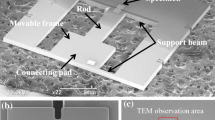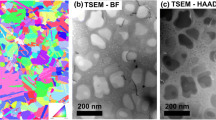Abstract
Fatigue crack growth rates were measured in vacuum in the temperature range from 100° to 250°C. At 200°C and above, crack growth occurs by a ductile mechanism. The ductile crack growth rate is proportional to the stress intensity factor amplitude raised to the 5/2 power, is equal to about one-tenth of the crack opening displacement per cycle, and is not measurably dependent on the peak stress intensity factor in the range measured. Local crack growth occasionally becomes arrested by large scale blunting of the crack tip. The fracture surface has many “river markings” and often adheres to specific growth planes on a scale of the grain size. The overall crack growth is approximately in the plane of maximum tensile stress. Inclusions and grain boundaries are not of importance in the growth mechanism in the range of crack growth rates measured. Growth rates in air at 200°C are at most twice those in vacuum. Although a mechanism, using continuum mechanical concepts, can explain the external features of the ductile crack growth rate, the local features showing a combination of all three modes of straining suggests that the actual process of crack growth must be far more complicated than hitherto realized. At 150°C and below, the ductile growth mechanism is augmented by the wholesale cleavage of single grains or grain clusters. The growth rates at these temperatures are higher and more sensitive to stress intensity factor amplitude.
Similar content being viewed by others
References
P. J. E. Forsyth:Acta Met., 1963, vol. 11, pp. 703–15.
J. Schijve: Am. Soc. Testing Mater., Spec. Tech. Publ. no. 415, pp. 415–57, 1967.
J. C. McMillan and R. M. N. Pelloux: Am. Soc. Testing Mater., Spec. Tech. Publ. no. 415, pp. 505–32, 1967.
F. J. Bradshaw:Scripta Met., 1967, vol. 1, pp. 41–43.
J. E. Srawley, M. H. Jones, and B. Gross: NASA TN D2396 National Aeronautics and Space Administration, 1964.
O. L. Bowie:J. Appl. Mech., 1964, vol. 31, pp. 208–12.
P. C. Paris and J. C. Sih: Am. Soc. Testing Mater., Spec. Tech. Publ. no. 381, pp. 30–81, 1965.
F. Erdogan:Fracture, Liebowitz, ed., vol. 2, pp. 497–590, Academic Press, New York and London, 1968.
W. Illg and A. J. McEvily: NASA TN D52 National Aeronautics and Space Administration, 1959.
D. Broek and J. Schijve: MLR-TR M.2111 National Aerospace Laboratory, Amsterdam, Netherlands, 1963.
F. Erdogan and R. Roberts:Proceedings of International Conference on Fracture (Sendai, Japan), Yokoboriet al., eds., vol. 1, pp. 341–62, The Japanese Society for Strength and Fracture of Materials, Sendai, 1966.
K. Erhardt and N. J. Grant:Fracture 1969, Pratt, ed., pp. 702–11, Chapman and Hall, London, 1969.
P. Neumann: 1969, Oral Discussion, Second International Conference on Fracture, Brighton, England; Argonne National Laboratory, Argonne, Illinois.
R. M. N. Pelloux:Fracture 1969, Pratt, ed., pp. 731–44, Chapman and Hall, London, 1969.
E. Orowan:Nature, 1941, vol. 147, pp. 452–54.
R. M. N. Pelloux:ASM Trans. Quart., 1964, vol. 57, pp. 511–18.
J. Kershaw and H. W. Liu: Met. F. 1340-0868-ITS Syracuse University, N.Y., 1969.
J. A. Hult and F. A. McClintock:Proc. Ninth International Congress of Applied Mechanics, (Brussels), vol. 8, pp. 51–58, Brussels, 1957.
F. A. McClintock: Am. Soc. Testing Mater., Spec. Tech. Publ. no. 415, pp. 170–74, 1967.
J. R. Rice: Am. Soc. Testing Mater., Spec. Tech. Publ. no. 415, p. 283, 1967.
C. Laird and G. C. Smith:Phil. Mag., 1962, vol. 7, pp. 847–58.
C. Laird: Am. Soc. Testing and Mater., Spec. Tech. Publ. no. 415, pp. 131–68, 1967.
E. Orowan: 1966, private communication, Department of Mechanical Engineering, M.I.T., Cambridge, Mass.
Author information
Authors and Affiliations
Rights and permissions
About this article
Cite this article
Wright, R.N., Argon, A.S. Fatigue crack growth in Si−Fe. Metall Trans 1, 3065–3074 (1970). https://doi.org/10.1007/BF03038420
Received:
Issue Date:
DOI: https://doi.org/10.1007/BF03038420




